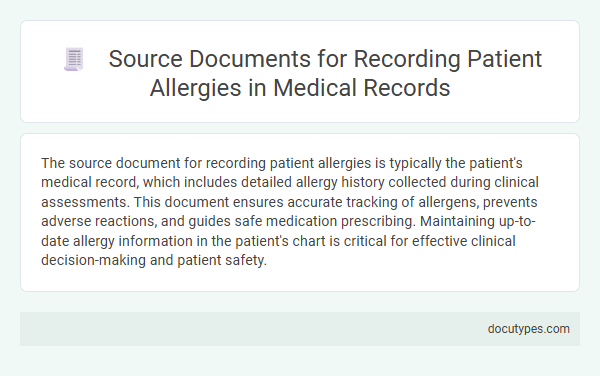The source document for recording patient allergies is typically the patient's medical record, which includes detailed allergy history collected during clinical assessments. This document ensures accurate tracking of allergens, prevents adverse reactions, and guides safe medication prescribing. Maintaining up-to-date allergy information in the patient's chart is critical for effective clinical decision-making and patient safety.
Introduction to Patient Allergy Documentation
| Introduction to Patient Allergy Documentation | |
|---|---|
| Definition | The source document for recording patient allergies is the primary medical record where allergy information is first documented and verified. This document serves as the authoritative reference for allergy data throughout the patient's medical history. |
| Importance | Accurate recording of allergies in the source document is critical for preventing adverse drug reactions, medication errors, and ensuring patient safety during diagnosis and treatment. |
| Typical Source Documents |
|
| Who Records It | Healthcare providers, including nurses, physicians, and medical assistants, collect and verify allergy information directly from you or your medical history, ensuring the source document contains accurate and up-to-date data. |
| Verification Process | Allergy information must be confirmed through patient interviews, previous medical records, or allergy testing before being entered into the source document. |
Importance of Accurate Allergy Recording in Medical Records
The source document for recording patient allergies is the patient's medical record, which includes detailed notes from healthcare providers during consultations. Accurate allergy documentation ensures that all healthcare professionals have access to critical information to prevent adverse reactions.
Precise allergy records are essential for patient safety and effective treatment planning. Inaccurate or missing allergy data can lead to severe allergic reactions, compromising patient health and treatment outcomes.
Types of Allergies Commonly Documented
The source document for recording patient allergies is the medical record, which ensures accurate and accessible allergy information. It is vital for healthcare providers to document allergies precisely to avoid adverse reactions during treatment.
- Drug Allergies - These include hypersensitivity reactions to medications such as antibiotics, analgesics, and anesthetics documented to prevent harmful exposure.
- Food Allergies - Commonly recorded food allergens like nuts, shellfish, and dairy help guide dietary restrictions and emergency care plans.
- Environmental Allergies - Allergies to pollen, dust mites, mold, and pet dander are noted to manage symptoms and inform treatment decisions for respiratory conditions.
Standard Source Documents for Allergy Information
The source document for recording patient allergies is crucial for accurate and safe medical treatment. Standard source documents ensure that allergy information is consistently and reliably documented.
- Patient Medical Records - These contain historical allergy data verified by healthcare professionals during previous visits.
- Patient Allergy Lists - Updated lists maintained within electronic health records (EHR) that capture current and confirmed allergies.
- Medication Administration Records (MAR) - These highlight any documented allergic reactions observed during medication administration.
Your healthcare provider relies on these standard source documents to prevent allergic reactions and provide effective care.
Role of Patient Intake Forms in Allergy Recording
The primary source document for recording patient allergies is the patient intake form. This form collects essential allergy information directly from the patient during their initial visit.
Patient intake forms play a critical role in allergy recording by capturing detailed data on known drug, food, and environmental allergies. Accurate documentation on these forms helps healthcare providers prevent adverse reactions and tailor treatment plans. Electronic health records often integrate intake form data to maintain up-to-date allergy histories throughout patient care.
Electronic Health Records (EHR) and Allergy Documentation
The primary source document for recording patient allergies is the Electronic Health Record (EHR), which serves as a centralized repository for all allergy information. Accurate allergy documentation within the EHR ensures that healthcare providers have immediate access to critical data, minimizing the risk of adverse drug reactions. You can trust that maintaining up-to-date allergy records in the EHR supports safer clinical decision-making and enhances patient care quality.
Verifying Allergy Information from External Medical Reports
What is the source document for recording patient allergies when verifying allergy information from external medical reports? The source document is typically the patient's official medical record maintained by the healthcare provider. It consolidates verified allergy data from external reports to ensure accuracy and patient safety.
Cross-Referencing Pharmacy and Laboratory Data
The primary source document for recording patient allergies is the electronic health record (EHR), which consolidates comprehensive patient information including allergy history. Cross-referencing pharmacy and laboratory data within the EHR enhances the accuracy of allergy documentation by verifying medication prescriptions and lab test results related to allergic reactions. This integrated approach reduces medication errors and supports safer clinical decision-making by providing real-time alerts and detailed patient allergy profiles.
Legal and Compliance Considerations in Allergy Recording
The source document for recording patient allergies is the official medical record, which ensures accurate and consistent documentation. Legal and compliance considerations mandate strict adherence to privacy, accuracy, and update protocols to protect patient safety and meet regulatory standards.
- Medical Record Integrity - The source document must be an authenticated, permanent part of the patient's health record to maintain legal validity.
- HIPAA Compliance - Allergy information must be documented and stored in a manner that protects patient confidentiality in accordance with HIPAA regulations.
- Accurate and Timely Updates - All allergy information must be recorded promptly and correctly to prevent clinical errors and ensure regulatory compliance.
What Is the Source Document for Recording Patient Allergies? Infographic

